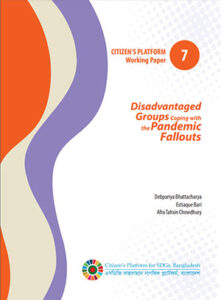 The COVID-19 pandemic had caused an enduring negative impact on the lives and livelihood of the disadvantaged communities of Bangladesh, i.e., the traditionally “left behind” and the newly “pushed behind” communities. In view of this crisis, the present study, through a face-to-face household survey, focuses
The COVID-19 pandemic had caused an enduring negative impact on the lives and livelihood of the disadvantaged communities of Bangladesh, i.e., the traditionally “left behind” and the newly “pushed behind” communities. In view of this crisis, the present study, through a face-to-face household survey, focuses
on the coping approaches undertaken by some specific disadvantaged groups in Bangladesh. This study points out that the households were faced with additional challenges during the pandemic, given their poor resilience to economic and environmental shocks. Thus, the paper highlights the types of approaches and their combinations pursued by these disadvantaged communities in order to cope with the fallouts.
In order to cope with the multifaceted impact of the pandemic, the households undertook individual behaviour-based approaches, for example, making consumption adjustments. These households also followed asset-based approaches like borrowing money and doing distress sales of assets. Further, these households often opted for assistance-based approaches like accessing public or private resource transfers. The survey findings indicated that taking loans and selling of assets, along with cutting back on food and non-food expenses, had been the dominant approach adopted by the sample households.
The study further elaborated on the recovery status of the households at the time of the survey and puts forward the perspectives about the near future. The study concludes that government support was instrumental for certain groups of households in speeding up the recovery process. Assuming that implications of the crisis may persist in the years to come, the study measures the options to be strengthened for coping for these disadvantaged communities.
Authors: Debapriya Bhattacharya, Estiaque Bari, Afra Tahsin Chowdhury
Publication Period: August 2023


Leave A Comment